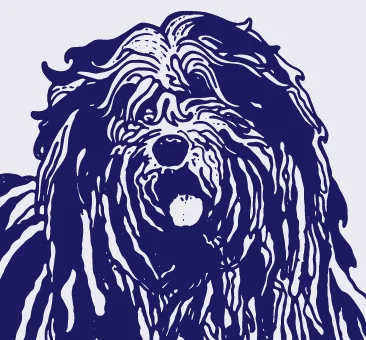The main function of the Bergamasco Sheepdog was to drive and guard the sheep herds, a task for which this active courageous, docile, intelligent and resourceful dog shows exemplary disposition.
The Bergamasco Sheepdog has two main, distinctive qualities, its aspect and its temperament. Both are the result of a long selective process carried out for the purpose of adapting the dog to its work and to the environment in which this was done. In order to understand the Bergamasco, we must consider its long history and heritage, assimilated in the selective process carried out by man. All these factors merge together to form a whole which is unique.
In order to define what is typical for a breed, it is necessary to study its history, the function for which it was selected as well as the environment in which it carried out its work.
The function for which a dog was selected determines the type of gait most suitable to perform it. The type of gait, in its turn, determines the characteristic morphology which, for practical purposes, is the result of adaptation to the particular function. For this reason, before studying the constructional characteristics of the Bergamasco, it is useful to go back to its origins and briefly consider the history of its evolution. The breed is still a carrier of antique and original characteristics, although others have been superimposed on them as the result of historical and environmental changes.
The first centers for domestication of sheep and goats appears to be the region extending from the foothills of the Zagros Mountains which straddle the Iraq-Iran border. In these same regions originate a type of dogs with long, bristly coats decedent from a wolf with a very thick coat: "Canis lupus laniger".
From these regions, these dogs emigrated with the population groups that moved from east to west in search of new pastures, settling in mountainous zones along a practically uninterrupted line from the upper planes of Asia over all the mountains of Anatolia, the Caucasus, the Carpathians, the Alps, the French Central Massif to the Pyrenees.
Along this route there is now a variety of breeds now stabilized and recognized, which are almost certainly direct descendants from this common ancestor. From a historical point of view, it is quite logical that a breed group with similarities is to be found along the itineraries followed by these migrant populations.
The characteristics shared by all these dogs are: a robust constitution and thick, rough haired coats with more or less pronounced tendencies to felting on all parts of the body including the head where the hair often forms a curtain in front of the eyes.
These characteristics have become inbred due to adaptation to the climate and geographical locations of their places of origin and maintained through environmental conditions.
The breeds which are known today for these characteristics are:
the Oftscharka in Russia
the Komondor and Puli in Hungary
the Polish Lowland Sheepdog in Poland
the Sheep Poedel in Germany, now very rare but not entirely extinct
the Bergamasco in the Italian Alps
the Briard in the French Alps
the Little Pyreneen Sheepdog in the French Alps
the Catalonian Sheepdog in the Spanish Pyrenees
A migratory current far further north could have been responsible for the presence of other dog breeds, probably of the same origin as the above: the Old English (Bobtail) Sheepdog which is still a working breed in northern England and the Scottish Highlands and the Bearded Collie in Great Britain. There is also mention of a Norwegian Sheepdog in days gone by.
Once these migratory populations abandoned their Nomad existence and settled down within limited territories, their inseparable companions, the dogs, underwent the same evolution. Together with their masters, the dogs settled down in all parts of Europe and lost contact with groups located elsewhere. Climatic conditions, environmental factors and the habits of the local populations with which they lived together, influenced the evolution of these isolated and habits underwent changes.
Each one of them assumed its own identity which made it different to its remote ancestor, but also different from that of other groups. However, even today, these differences are not so great that we cannot recognize the common origin.
The ancestors of our modern Bergamasco arrived in Italy in the wake of migratory populations moving west and spreading right over the flanks of the Alps, following the itinerary traced by the population which skirted the mountainous zones from Asia to Europe.





